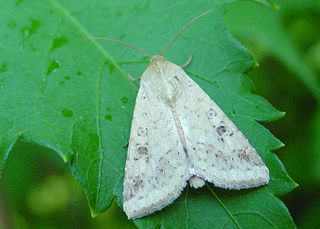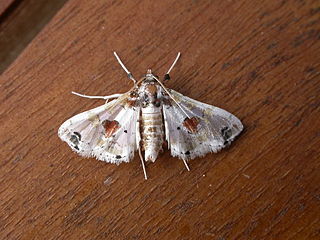
Helicoverpa armigera is a species of Lepidoptera in the family Noctuidae. It is known as the cotton bollworm, corn earworm, Old World (African) bollworm, or scarce bordered straw. The larvae feed on a wide range of plants, including many important cultivated crops. It is a major pest in cotton and one of the most polyphagous and cosmopolitan pest species. It should not be confused with the similarly named larva of the related species Helicoverpa zea.

Cochliobolus miyabeanus is a fungus that causes brown spot disease in rice.

Pectobacterium carotovorum is a bacterium of the family Pectobacteriaceae; it used to be a member of the genus Erwinia.
Mycosphaerella henningsii is a fungal plant pathogen that causes Brown leaf spot (BLS) in cassava).Part

Sarocladium oryzae (Sawada) is a plant pathogen causing the Sheath rot disease of rice and Bamboo blight of Bambusoideae spp. in Asia.

Colletotrichum orbiculare is a plant pathogen of melons and cucumber. It causes the disease anthracnose that can effect curcubits causing lesions on various parts of the plant. It can effect cucumbers, melon, squash, watermelon and pumpkin, especially when the weather is rainy, humid and warm. It can be transmitted by seed as well as soil and survive between crops. It is also spread by feeding cucumber beetles, splashing water, tools and workers. Efforts to control the fungus include the practice of rotating cucurbits out for a 2-year period, planting cultivars with resistance, burning infected crops and careful control of weeds. Chemical control measures are also available.
Colletotrichum truncatum is a fungal species and plant pathogen on soybeans.

Colletotrichum sublineola is a plant pathogen that causes anthracnose in wild rice and sorghum

Colletotrichum musae is a plant pathogen primarily affecting the genus Musa, which includes bananas and plantains. It is best known as a cause of anthracnose indicating ripeness on bananas.

Cassava mosaic virus is the common name used to refer to any of eleven different species of plant pathogenic virus in the genus Begomovirus. African cassava mosaic virus (ACMV), East African cassava mosaic virus (EACMV), and South African cassava mosaic virus (SACMV) are distinct species of circular single-stranded DNA viruses which are transmitted by whiteflies and primarily infect cassava plants; these have thus far only been reported from Africa. Related species of viruses are found in India and neighbouring islands, though cassava is cultivated in Latin America as well as Southeast Asia. Nine species of cassava-infecting geminiviruses have been identified between Africa and India based on genomic sequencing and phylogenetic analysis. This number is likely to grow due to a high rate of natural transformation associated with CMV.

Maize dwarf mosaic virus (MDMV) is a pathogenic plant virus of the family Potyviridae. Depending on the corn plant’s growth stage, the virus can have severe implications to the corn plant’s development which can also result in economic consequences to the producer of the crop.
Tobacco necrosis virus A (TNV) is a plant pathogenic virus of the family Tombusviridae.

Sugarcane mosaic virus (SCMV) is a plant pathogenic virus of the family Potyviridae. The virus was first noticed in Puerto Rico in 1916 and spread rapidly throughout the southern United States in the early 1920s. SCMV is of great concern because of the high economic impact it has on sugarcane and maize.
Rice yellow mottle virus (RYMV) is a plant pathogenic virus, belonging to the genus Sobemovirus. The genome is a positive-sense single strand RNA of 4450 nucleotides in length and is not polyadenylated. It was first reported in Kenya in 1966 in one of Africa's first cultivation intensification schemes, due to RYMV's association with intensification, but DNA analysis of its evolutionary history shows it to have evolved in East Africa in the 19th century. Since its identification in Kenya it has been detected in many countries in sub-Saharan Africa. It has also been detected in Central Africa, but has yet to be seen outside the continent. The genomic organization of RYMV is most similar to that of Cocksfoot mottle sobemovirus. RYMV is one of the better-studied plant-virus pathosystems.

Orthotospovirus is a genus of negative-strand RNA viruses, in the family Tospoviridae of the order Bunyavirales, which infects plants. Tospoviruses take their name from the species Tomato spotted wilt orthotospovirus (TSWV) which was discovered in Australia in 1919. TSWV remained the only known member of the family until the early 1990s when genetic characterisation of plant viruses became more common. There are now at least twenty species in the genus with more being discovered on a regular basis. Member viruses infect over eight hundred plant species from 82 different families.
Machlomovirus is a genus of plant viruses, in the family Tombusviridae. Plants serve as natural hosts. There is only one species in this genus: Maize chlorotic mottle virus (MCMV), which causes significant losses in maize production worldwide. MCMV was first identified in the U.S. state of Kansas causing Maize lethal necrosis disease/MLN/corn lethal necrosis, a severe disease that negatively affects all stages of development for maize plants.

Leucinodes orbonalis, the eggplant fruit and shoot borer or brinjal fruit and shoot borer, is a moth species in the genus Leucinodes described by Achille Guenée in 1854. Its native distribution is in the tropical and subtropical parts of Australia and Asia, where it is recorded from Pakistan, Nepal, India, including the Andaman Islands, Sri Lanka, Bangladesh, Myanmar, Laos, Cambodia, Vietnam, Thailand, China, Taiwan, Japan, Malaysia, Singapore, Brunei, the Philippines, and Indonesia (Java). It has also been intercepted from fruit imports in the U.S.A., the Netherlands, Denmark and Great Britain, where it was also reported from the wild. A taxonomic revision of the Leucinodes species of Sub-Saharan Africa concluded that L. orbonalis is currently not present in Africa, and that previous records of this species were misidentifications of previously undescribed species.

Busseola fusca is a species of moth that is also known as the maize stalk borer. It is known from Ethiopia.

Banana Xanthomonas Wilt (BXW), or banana bacterial wilt (BBW) or enset wilt is a bacterial disease caused by Xanthomonas campestris pv. musacearum. After being originally identified on a close relative of banana, Ensete ventricosum, in Ethiopia in the 1960s, BXW emanated in Uganda in 2001 affecting all types of banana cultivars. Since then BXW has been diagnosed in Central and East Africa including banana growing regions of: Rwanda, Democratic Republic of the Congo, Tanzania, Kenya, Burundi, and Uganda.

Prostephanus truncatus is commonly referred to as larger grain borer (LGB) with reference to the related Rhyzopertha dominica, which is relatively smaller, and referred to as the lesser grain borer. P. truncatus is about 6 mm (0.24 in) long as compared to 3 mm (0.12 in) long in R. dominica. At optimum conditions of 80% relative humidity and 32 °C (90 °F), and available food, P. truncatus completes its lifecycle within 27 days. It is a serious pest of dried grains, especially maize and dried cassava in West Africa. This beetle is believed to have been introduced into West Africa through food aid from America. It reached Africa through Tanzania in the early 1970s.
![]() This article incorporates text from a free content work. Licensed under CC-BY-SA( license statement/permission ). Text taken from Plantwise Factsheets for Farmers: Control vectors of Maize Lethal Necrotic Disease , Joyce G. Kessy, CABI.
This article incorporates text from a free content work. Licensed under CC-BY-SA( license statement/permission ). Text taken from Plantwise Factsheets for Farmers: Control vectors of Maize Lethal Necrotic Disease , Joyce G. Kessy, CABI. ![]() This article incorporates text from a free content work. Licensed under CC-BY-SA( license statement/permission ). Text taken from Plantwise Factsheet for Farmers: Prevention and detection of Maize Lethal Necrosis Disease , Hiwot Lemma, Daniel W. Michael, Mhreteab Tsegay, CABI.
This article incorporates text from a free content work. Licensed under CC-BY-SA( license statement/permission ). Text taken from Plantwise Factsheet for Farmers: Prevention and detection of Maize Lethal Necrosis Disease , Hiwot Lemma, Daniel W. Michael, Mhreteab Tsegay, CABI. ![]() This article incorporates text from a free content work. Licensed under CC-BY-SA( license statement/permission ). Text taken from PMDG: Maize Lethal Necrosis Disease (MLND) (Ethiopia) , Kassahun Sedessa (EIAR), Mebrahtom G/kidan (TBoARD), Habtie Abate (S/Gondar Agri Dept, Amhara), CABI.
This article incorporates text from a free content work. Licensed under CC-BY-SA( license statement/permission ). Text taken from PMDG: Maize Lethal Necrosis Disease (MLND) (Ethiopia) , Kassahun Sedessa (EIAR), Mebrahtom G/kidan (TBoARD), Habtie Abate (S/Gondar Agri Dept, Amhara), CABI. ![]() This article incorporates text from a free content work. Licensed under CC-BY-SA( license statement/permission ). Text taken from PMDG: Maize lethal necrosis disease in maize (Zambia) , Mathews Matimelo (ZARI), CABI.
This article incorporates text from a free content work. Licensed under CC-BY-SA( license statement/permission ). Text taken from PMDG: Maize lethal necrosis disease in maize (Zambia) , Mathews Matimelo (ZARI), CABI. 













